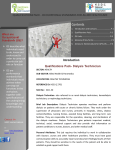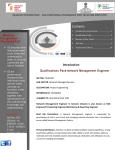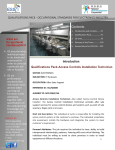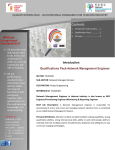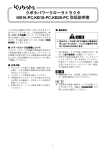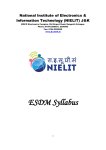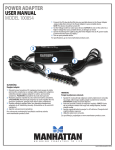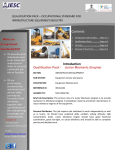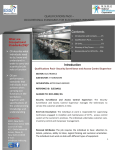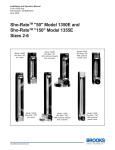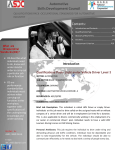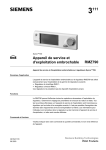Download Welding Technician Level 4
Transcript
h Automotive Skills Development Council QUALIFICATIONS PACK - OCCUPATIONAL STANDARDS FOR AUTOMOTIVE INDUSTRY Contents 1. Introduction and Contacts..….……….…….P.1 2. Qualifications Pack……….………………........P.2 3. Glossary of Key Terms …..…………...........P.3 4. NOS Units……………………..……….……..……..P.6 OS describe what individuals need to do, know and understand in order to carry out a particular job role or function OS are performance standards that individuals must achieve when carrying out functions in the workplace, together with specifications of the underpinning knowledge and understanding ASDC, Core 4-B, 5th Floor, India Habitat Centre, Lodhi Road,New Delhi E-mail: [email protected] 5. Assessment Criterion………………………….P.43 Introduction Qualifications Pack- Welding Technician L4 SECTOR: AUTOMOTIVE SUB-SECTOR: MANUFACTURING OCCUPATION: WELDING JOB ROLE: WELDER REFERENCE ID: ASC/Q3103 ALIGNED TO: NCO-2004/7212.10/7212.20/7212.30 Welder:Also known as Welding technician, this role is similar for all types of joining techniques like Gas Discharge Arc Welding ( MIG, MAG, TIG), Resistance Welding (Spot Welding, Projection Welding, Butt Welding) and Automatic or Robotic Welding Process . Brief Job Description:This role is responsible for joining various types of metallic frames, structures, jigs, plates, sheets etc using heating and melting process created through electrical power and gaseous discharge, maintaining process parameters, conducting quality checks on output product and maintaining a safe & healthy working environment on the shop floor. Personal Attributes: Reading, writing and communication skills, ability to plan and prioritize, quality consciousness, sensitivity to problem solving, quick decision making, safety orientation, Dexterity, Hand eye coordination, high precision, ability to use internal ERP systems ( if existing), Good vision, no color blindness Qualifications Pack For Welding Technician Level 4 / Welder Job Details Qualifications Pack Code Job Role ASC/Q3103 Welding Technician Level 4 /Welder Credits(NSQF) TBD Version number 1.1 Industry Automotive Drafted on 15/8/2013 Sub-sector Manufacturing Last reviewed on 30/8/2013 Occupation Welding Next review date 30/8/2015 Job Role NSQF level Welding Technician Level 4 /Welder The role is responsible for joining various types of metallic frames, structures, jigs, plates, sheets etc. using heating and melting process created through electrical power and gaseous discharge, maintaining process parameters, conducting quality checks on output product and maintaining a safe & healthy working environment on the shop floor 4 Minimum Educational Qualifications ITI – Mechanical/ Welding Technology Maximum Educational Qualifications Class 12 Role Description Training (Suggested but not mandatory) Experience Occupational Standards (OS) 2|Page Different Welding techniques used in organizations Geometric Dimensioning and Tolerance Different welding standards 5S and Safety aspects Problem Solving Techniques Quality Management Systems Knowledge of IT systems and ERP 3-4 years in welding process 1. ASC/N3107: Understanding and interpreting engineering drawings and sketches 2. ASC/N3108:Understand processes and equipment requirement to complete the task 3. ASC/N3109:Preparing the machine, auxiliaries and work pieces for the welding process 4. ASC/N3110: Support the robotic engineer/ master technician in programming the welding machine control Qualifications Pack For Welding Technician Level 4 / Welder 5. 6. 7. 8. Performance Criteria 3|Page mechanism ADC/N3111:Conduct the Welding process and weld the work pieces ASC/N3112:Ensure completion of post operations activities of inspection, storage and maintenance ASC/N0006A: Maintain a safe and healthy working environment at the workplace ASC/N0021: Maintaining 5S at the work premises As described in the relevant NOS units Qualifications Pack For Welding Technician Level 4 / Welder Definitions Keywords /Terms Core Skills/Generic Skills Function Job role Knowledge and Understanding National Occupational Standards (NOS) Occupation Organisational Context Performance Criteria Qualifications Pack(QP) Qualifications Pack Code Scope Sector 4|Page Description Core Skills or Generic Skills are a group of skills that are key to learning and working in today's world. These skills are typically needed in any work environment. In the context of the NOS, these include communication related skills that are applicable to most job roles. Function is an activity necessary for achieving the key purpose of the sector, occupation, or area of work, which can be carried out by a person or a group of persons. Functions are identified through functional analysis and form the basis of NOS. Job role defines a unique set of functions that together form a unique employment opportunity in an organization. Knowledge and Understanding are statements which together specify the technical, generic, professional and organizational specific knowledge that an individual needs in order to perform to the required standard. NOS are Occupational Standards which apply uniquely in the Indian context Occupation is a set of job roles, which perform similar/related set of functions in an industry. Organisational Context includes the way the organization is structured and how it operates, including the extent of operative knowledge managers have of their relevant areas of responsibility. Performance Criteria are statements that together specify the standard of performance required when carrying out a task. Qualifications Pack comprises the set of NOS, together with the educational, training and other criteria required to perform a job role. A Qualifications Pack is assigned a unique qualification pack code. Qualifications Pack Code is a unique reference code that identifies a qualifications pack. Scope is the set of statements specifying the range of variables that an individual may have to deal with in carrying out the function which have a critical impact on the quality of performance required. Sector is a conglomeration of different business operations having similar businesses and interests. It may also be defined as a distinct subset of the economy whose components share similar characteristics and interests. Qualifications Pack For Welding Technician Level 4 / Welder Sub-Sector Sub-functions Technical Knowledge Unit Code Unit Title Vertical Sub-sector is derived from a further breakdown based on the characteristics and interests of its components. Sub-functions are sub-activities essential to fulfil the achieving the objectives of the function. Technical Knowledge is the specific knowledge needed to accomplish specific designated responsibilities. Unit Code is a unique identifier for a NOS unit, which can be denoted with an ‘N’ Unit Title gives a clear overall statement about what the incumbent should be able to do. Vertical may exist within a sub-sector representing different domain areas or the client industries served by the industry. Acronyms Keywords /Terms Description NOS National Occupational Standard(s) NVEQF National Vocational Education Qualifications Framework NVQF National Vocational Qualifications Framework NSQF National Skills Qualifications Framework OEM Original Equipment Manufacturer OS Occupational Standard(s) QP Qualifications Pack MIG Metal Inert Gas TIG Tungsten Inert Gas MAG Metal Active Gas 5|Page ASC/N3107: Understanding and interpreting engineering drawings and sketches National Occupational Standard Overview This unit is about understanding the product design and work order requirements by analyzing the available engineering drawings and sketches. 6|Page National Occupational Standard ASC/N3107: Understanding and interpreting engineering drawings and sketches Unit Code ASC/N3107 Unit Title (Task) Description Scope Understanding and interpreting engineering drawings and sketches This NOS unit is about analyzing the work/ job requirements by interpreting the drawings and sketches provided by the supervisor, understanding measurement dimensions and applying the knowledge to determine the process which needs to be followed to create the work order as per the specifications mentioned in the work order The welder will be responsible for understanding the work order, engineering drawing and sketches storing the drawings in the correct place escalations of any queries regarding the job The job holder will cover all types of Arc and Resistance welding methods for joining auto components and vehicle body. The role holder will interact with the assembly line, paint shop, maintenance team and material management team Performance Criteria(PC) w.r.t. the Scope Element Identify the right drawing to be used for the process Understand the engineering drawings, sketches and work order and identify required work steps Documentation and storage of the drawings/ sketches Performance Criteria PC1. PC2. Check the version of the engineering drawing provided. Select the latest version of the available engineering drawing so that the final measurements and design is available with the team PC3. Thoroughly understand the work order ( work output – Trail or production) required from the process PC4. Refer all engineering drawings and sketches related to the work output to understand the measurement dimensions, geometric dimensions and shape of the required work output PC5. Identify the required activities which need to be executed in order achieve the final output as per the work order PC6. Ensure that the processes adopted including parameters and process sequences are according to the Work Instructions/ Standard Operating Procedures adopted PC7. Understand the checking method and the frequency as mentioned in the work instructions PC8. Clearly understanding the does and don’ts of the manufacturing process as defined in SOPs/ Work Instructions or defined by supervisors PC9. Store the drawings in a proper place where they cannot be damaged by moisture, chemicals, fire and can be easily accessed by the user PC10. Observe any modification, changes required in the drawing and communicate the same to the concerned team in the organization Knowledge and Understanding (K) 7|Page ASC/N3107: Understanding and interpreting engineering drawings and sketches The user/individual on the job needs to know and understand: A. Organizational KA1. relevant process standards and procedures followed in the company Context KA2. different types of products manufactured by the company (Knowledge of the KA3. Internal processes like store management, inventory management, quality company / management and key contact points for query resolution organization and its processes) B. Technical Knowledge The user/individual on the job needs to know and understand: KB1. sketches and engineering drawings and how to interpret meaningful information from the drawings KB2. dimensions and characteristics of the final product output KB3. different types of welding processes and associated equipments KB4. different types of welds and joints KB5. different processes used in welding and metallurgy KB6. basic principles of geometric shapes, tolerances and drawing KB7. the impact of various physical parameters like temperature, pressure, , cycle time, electrode distance on the properties of final output product like durability, strength etc. Skills (S) [Optional] Element Skill A. Core Skills/ Generic Skills Writing Skills The user/ individual on the job needs to know and understand how to: SA1. document information from the sketches and engineering drawings SA2. prepare draft drawings for the final output product SA3. note down observations (if any) related to the welding process SA4. write information documents to internal departments/ internal teams or enter the information in online ERP systems under guidance of the supervisor Reading Skills The user/individual on the job needs to know and understand how to: SA5. read and interpret engineering drawing and sketches SA6. read and interpret symbols and measurements used in the drawings SA7. read equipment manuals and process documents to understand the equipments and processes better SA8. read internal information documents sent by internal teams Oral Communication (Listening and Speaking skills) B. Professional Skills 8|Page The user/individual on the job needs to know and understand how to: SA9. discuss task lists, schedules and activities with the supervisor SA10. effectively communicate with the team members SA11. question the operator/ Welding shop supervisor in order to understand the nature of the problem and to clarify queries SA12. attentively listen with full attention and comprehend the information given by the speaker Plan and Organize ASC/N3107: Understanding and interpreting engineering drawings and sketches The user/individual on the job needs to know and understand how to: SB1. plan and organize the work order and jobs received from the supervisor SB2. organize all process/ equipment manuals so that sorting/ accessing information is easy SB3. support the supervisor in scheduling tasks for helper and assistant welder Judgment and Critical Thinking The user/individual on the job needs to know and understand how to: SB4. use common sense and make judgments during day to day basis SB5. use reasoning skills to identify and resolve basic problems SB6. use intuition to detect any potential problems which could arise during operations SB7. use acquired knowledge of the process for new developments , trials Desire to learn and take initiatives The user/individual on the job needs to know and understand how to: SB8. follow instructions and work on areas of improvement identified SB9. complete the assigned tasks with minimum supervision SB10. complete the job defined by the supervisor within the timelines & quality norms Problem Solvingand Decision making The user/individual on the job needs to know and understand how to: SB11. detect problems in day to day tasks with keen observations SB12. support supervisor in using specific problem solving techniques and detailing out the problems SB13. discuss possible solution with the supervisor for problem solving SB14. make decisions in emergency conditions in case the supervisor is not available( as per the authority matrix defined by the organization) NOS Version Control NOS Code ASC/N3107 Credits(NSQF) TBD Version number 1 Industry Industry Sub-sector Automotive Manufacturing Drafted on Last reviewed on 15/8/2013 30/8/2013 Occupation Welding Next review date 30/8/2015 9|Page ASC/N3108: Understanding process and equipment requirement to complete the task National Occupational Standards ----------------------------------------------------------------------------------------------------------------------------- ---------- Overview This unit is about understanding the job requirement and hence understand the activities & equipment associated with the process to complete the task. 10 | P a g e National Occupational Standard ASC/N3108: Understanding process and equipment requirement to complete the task Unit Code ASC/N3108 Unit Title (Task) Description Scope Understanding process and equipment requirement to complete the task This NOS unit is about understanding the job requirement, what processes need to be executed, what equipments will be used for the project and what is the required output considering the standards specified The welder will be responsible for understanding the equipment and material requirement escalations of any queries regarding the job The job holder will cover all types of Arc and Resistance weldingmethods for joining auto components and vehicle body. The role holder will interact with the assembly line, paint shop, maintenance team and material management team Performance Criteria (PC) w.r.t. the Scope Element Understand the welding requirements, welding equipment and parameters to be set for the process Escalations of queries on the given job Performance Criteria PC1. Understand the right welding methodology and process to be adopted for completing the work order through discussions with the supervisor/ master technician for the new job and reading the process manuals/ Work Instructions/Standard Operating Procedures for the production job PC2. Understand the various welding parameters like temperature, pressure, electrode type, electrode distance, process cycle timeetc before starting the welding process, as mentioned in the Work Instructions/ SOP manual PC3. Understand the material required and the equipment availability for executing the activity PC4. Understand the type of electrodes – material wise & dimension wise, type of filler material etc used for the welding process PC5. Understand the application of fixtures, process sequence, poka yoke as applicable PC6. Correctly understand the type of electrode in terms of electrode material and thickness, filler material and flux which will be required for the selected welding process before the initiation of the welding process PC7. Refer the queries to a competent internal specialist if they cannot be resolved by the welder on own PC8. Obtain help or advice from specialist if the problem is outside the area of competence or experience PC9. Confirm self understanding to the specialist during discussion so that all doubts & queries can be resolved before the actual process execution Knowledge and Understanding (K) w.r.t. the scope Element Knowledge and Understanding A. Organizational Context (Knowledge of the company / organization and The user/individual on the job needs to know and understand: KA1. relevant standards and procedures followed in the company KA2. different types of products manufactured by the company KA3. functional processes like Procurement, Store management, inventory management, quality management and key contact points for query resolution 11 | P a g e ASC/N3108: Understanding process and equipment requirement to complete the task its processes) B. Technical Knowledge The user/individual on the job needs to know and understand: KB1. different types of welding processes and associated equipments KB2. different types of joints KB3. the method of reading and interpreting sketches and engineering drawings KB4. how to visualize the final product output KB5. the impact of various physical parameters like temperature, pressure, electrode distance, electric current, voltage on the properties of final output product like durability, ductility, surface finishetc KB6. basic principles of geometric shapes and engineering drawing KB7. metallurgical properties of materials KB8. hazards and safety aspects involved in welding activities & usage of relevant PPEs Skills (S) [Optional] Element Skills Element A. Core Skills/ Generic Skills Writing Skills The user/ individual on the job needs to know and understand how to: SA1. document information from the sketches and engineering drawings SA2. prepare draft drawings as per requirement for the final output product/ internal communication for a problem, MIS SA3. note down observations (if any) related to the welding process SA4. write information documents to internal departments/ internal teams or enter the information in online ERP systems under guidance of the supervisor Reading Skills The user/individual on the job needs to know and understand how to: SA5. read and interpret engineering drawing and sketches SA6. read and interpret symbols and measurements used in the drawings SA7. read equipment manuals and process documents to understand the equipments and processes better SA8. read internal information documents sent by internal teams Oral Communication (Listening and Speaking skills) B. Professional Skills 12 | P a g e The user/individual on the job needs to know and understand how to: SA9. discuss task lists, schedules and activities with the supervisor SA10. effectively communicate with the team members SA11. question the Welding shop supervisor in order to understand the nature of the problem and to clarify queries SA12. attentively listen with full attention and comprehend the information given by the speaker Plan and Organize ASC/N3108: Understanding process and equipment requirement to complete the task The user/individual on the job needs to know and understand how to: SB1. plan and organize the work order and jobs received from the supervisor SB2. organize all process/ equipment manuals so that sorting/ accessing information is easy SB3. support the supervisor in scheduling tasks for helper and assistant operator Judgment and Critical Thinking The user/individual on the job needs to know and understand how to: SB4. use common sense and make judgments during day to day basis SB5. use reasoning skills to identify and resolve basic problems SB6. use intuition and keen observation to detect any potential problems which could arise during operations Desire to learn and take initiatives The user/individual on the job needs to know and understand how to: SB7. follow instructions and work on areas of improvement identified SB8. complete the assigned tasks with minimum supervision SB9. use acquired process knowledge for new jobs in a Cross Functional Team SB10. complete the job defined by the supervisor within timelines and quality norms Problem Solvingand Decision making The user/individual on the job needs to know and understand how to: SB11. detect problems in day to day tasks SB12. support supervisor in using specific problem solving techniques and detailing out the problems SB13. discuss possible solution with the supervisor for problem solving SB14. make decisions in emergency conditions in case the supervisor is not available( as per the authority matrix defined by the organization) NOS Version Control NOS Code ASC/N3108 Credits(NSQF) TBD Version number 1 Industry Industry Sub-sector Automotive Manufacturing Drafted on Last reviewed on 15/8/2013 30/8/2013 Occupation Welding Next review date 30/8/2015 13 | P a g e ASC/N3109:Preparing the welding machine, auxiliary apparatus and metal work pieces for the welding process National Occupational Standards ---------------------------------------------------------------------------------------------------------------------------- ----------- Overview This unit is about preparing the welding machine, auxiliary apparatus like transformers, gas cylinder, flux wires etc and metal work pieces( jigs) for the welding process. 14 | P a g e ASC/N3109:Preparing the welding machine, auxiliary apparatus and metal work pieces for the welding process National Occupational Standard Unit Code Unit Title (Task) Description Scope ASC/N3109 Preparing the welding machine, auxiliary apparatus and metal work pieces for the welding process This NOS unit is about preparing the surface of the metal parts by removing dust, moistures, rough edges etc, cleaning the welding apparatus and the electrodes and installing the metal parts (Jigs)& electrodes on the welding machine/ assembly block The welder will be responsible for arranging the required electrodes and material for welding cleaning and setting up of the machine preparing the surface of the work pieces The job holder will cover all types of Arc and Resistance welding methods for joining auto components and vehicle body. The role holder will interact with the assembly line, paint shop, maintenance team and material management team Performance Criteria (PC) w.r.t. the Scope Element Arrange for electrodes and material as per the requirement of the welding process Clean and setup the welding equipment Prepare the surface of the part ( work pieces) on which welding needs to be conducted Escalations of queries for the given job 15 | P a g e Performance Criteria PC1. Understand the material required and the equipment availability for executing the activity PC2. Ensure that the required material is procured from the store before starting the welding process PC3. Ensure that the helper/ assistant technician brings the required material and tools before the start of the welding operations PC4. Ensure that the helper/ assistant operator clean the surface of the electrodes and the welding gun to remove dust and any other impurities PC5. Ensure that the helper/ assistant operator clean other welding machine auxiliaries(Welding Transformer, Gas Discharge unit, Flux wire) before the initiation of the welding process, as mentioned in the Work Instructions/ Standard Operating Procedures(SOP) PC6. Setup the welding apparatus as per the selected welding processand the internal SOPs/ Work Instructions and the setting standards for the machine PC7. Ensure that the helper/ assistant operator clean the surface to the metal parts (work pieces) which need to be joined PC8. Correctly compare the dimensions of the work pieces available on the welding line with the product drawing/ sketches available with the operator PC9. Ensure that in case the parts are not as per the given measurements, the helper/ assistant operator remove any extra material, sharp edges etc which might impact the final welded products PC10. Immediately refer the queries to the supervisor to avoid any delay in the actual process PC11. Confirm self understanding to the supervisor/ master technician once the query is resolved so that all doubts & queries can be resolved before the actual process execution ASC/N3109:Preparing the welding machine, auxiliary apparatus and metal work pieces for the welding process Knowledge and Understanding (K) w.r.t. the scope Element Knowledge and Understanding A. Organizational Context (Knowledge of the company / organization and its processes) The user/individual on the job needs to know and understand: KA1. relevant standards and procedures followed in the company KA2. different types of products manufactured by the company KA3. functional processes like Procurement, Store management, inventory management, quality management and key contact points for query resolution B. Technical Knowledge The user/individual on the job needs to know and understand: KB1. different types of welding processes and associated equipments KB2. different cleaning methods for electrodes, metal surfaces etc KB3. how to use measuring instruments like verniercalipers, micrometres KB4. different types of joints, metallurgy relevant to welding KB5. how to read and interpret sketches, engineering drawings and symbols used in welding sketches and charts KB6. different welding standards for the automobile industry KB7. the impact of various physical parameters like temperature, pressure, electrode distance, electric current, voltage on the properties of final output product like durability, strength etc. KB8. basic principles of geometric shapes, dimensions and tolerances KB9. basic principles of safety and 5S in the manufacturing line KB10. knowledge of electrode preparation and work piece preparation for different welding methods Skills (S) w.r.t. the scope Element Skills A. Core Skills/ Generic skills Writing Skills The user/ individual on the job needs to know and understand how to: SA1. document information from the sketches and engineering drawings SA2. prepare draft drawings/ sketches for the final output product and internal communication SA3. note down observations (if any) related to the welding process SA4. write information documents to internal departments/ internal teams or SA5. enter the information in online ERP systems under guidance of the supervisor Reading Skills The user/individual on the job needs to know and understand how to: SA6. read and interpret engineering drawing and sketches SA7. read and interpret symbols and measurements used in the drawings SA8. read equipment manuals and process documents to understand the equipments and processes better SA9. read internal information documents sent by internal teams Oral Communication (Listening and Speaking skills) 16 | P a g e ASC/N3109:Preparing the welding machine, auxiliary apparatus and metal work pieces for the welding process The user/individual on the job needs to know and understand how to: SA10. discuss task lists, schedules and activities with the supervisor SA11. effectively communicate with the team members SA12. question the Welding shop supervisor in order to understand the nature of the problem and to clarify queries SA13. attentively listen with full attention and comprehend the information given by the speaker Plan and Organize B. Professional Skills The user/individual on the job needs to know and understand how to: SB1. plan and organize the work order and jobs received from the Operator SB2. organize all process/ equipment manuals so that sorting/ accessing information is easy Analytical Thinking The user/individual on the job needs to know and understand how to: SB3. visualize the final job product after understanding the given drawing/ sketches SB4. co relate the type of job output required with the welding methodology to be used when working for a new product development SB5. identify the strengths and weakness of various welding process Judgment and Critical Thinking The user/individual on the job needs to know and understand how to: SB6. use common sense and make judgments during day to day basis SB7. use reasoning skills to identify and resolve basic problems Desire to learn and take initiatives The user/individual on the job needs to know and understand how to: SB8. follow instructions and work on areas of improvement identified complete the assigned tasks with minimum supervision SB9. complete the job defined by the supervisor within the timelines & quality norms SB10. take self initiatives in driving small projects with the supervisor like operation improvement, training of helpers and assistant operators, 5S, Kaizen etc NOS Version Control NOS Code ASC/N3109 Credits(NSQF) TBD Version number 1 Industry Automotive Drafted on 15/8/2013 Industry Sub-sector Manufacturing Last reviewed on 30/8/2013 Occupation Welding Next review date 30/8/2015 17 | P a g e ASC/N3109:Preparing the welding machine, auxiliary apparatus and metal work pieces for the welding process 18 | P a g e ASC/N3110: Support the engineer/ master technician in programming the robotic welding machine National Occupational Standard -------------------------------------------------------------------------------------------------------------------------------------------- Overview This unit is about supporting the Robotics Engineer/ Master Technician in programming the welding machine control mechanism with the required process parameters and monitor the Robotic Welding Operations. 19 | P a g e National Occupational Standard ASC/N3110: Support the engineer/ master technician in programming the robotic welding machine Unit Code ASC/N3110 Unit Title (Task) Description Scope Support the Robotics Engineer/ Master Technician in programming the control parameters This NOS is about supporting the Robotics Engineer / Master Technician/ machine setter in programming the welding machine control mechanism with the required process parameters and monitor the Robot Weld Operations The welder will be responsible for supporting the master technician/ machine setter in programming the robots monitoring process parameters The job holder will cover all types of Arc and Resistance welding methods for joining auto components and vehicle body. The role holder will interact with the assembly line, paint shop, maintenance team and material management team Performance Criteria(PC) w.r.t. the Scope Element Performance Criteria Support the programming of the Robotic Welding machine PC1. Understand the capabilities of the Robotic Welding Machine and link it to the nature of job, location of the weld, axis movements, speed, hydraulicsetc PC2. Understand basic Robotic Operations by referring the user manual for the welding apparatus PC3. Support the Programming Engineer/ Master Technician/ Machine Setter in correctly programming the basic level activities related to path plan, extension and trajectory of various parts of the Robotic Welding apparatus - arm, gripper, joints, extensions across X, Y and Z axis and the welding cycle time ( ON/ OFF) time PC4. Support the Programming Engineer/ Machine Setter in programming the start/stop time of weld machine and cycle time for the arm movements (acceleration, slowing) PC5. Observe the coordination of robotic arm movement and sensors with the movement of the work pieces on the welding platform and loading/ unloading of the work pieces, Tip cleaning process etc PC6. Monitor the welding process ( Pressure, Temperature, gas discharge flow, electrode force, electrode distance etc) by observing the readings on the panels/ measuring instruments to prevent any harm to the work pieces due to overheating, burning, over melting, change in applied pressure etc PC7. Inform the Supervisor/ Master Technician about any process irregularities observed in the Robotic Welding Process Monitor process parameters to ensure error free welding process Knowledge and Understanding (K) A. Organizational Context (Knowledge of the company / organization and 20 | P a g e The user/individual on the job needs to know and understand: KA1. different types of products manufactured by the company KA2. functional processes like Procurement, Store management, inventory management, quality management and key contact points for query resolution KA3. Quality Management Systems for the organization ASC/N3110: Support the engineer/ master technician in programming the robotic welding machine processes B. Technical Knowledge The user/individual on the job needs to know and understand: KB1. different types of welding processes in Resistance Welding and Gas Discharge welding techniques and associated equipments KB2. different types of joints used in welding KB3. basic knowledge of electronics and robotic process KB4. different cleaning methods for electrodes, metal surfaces etc KB5. various National and International welding standards used in automotive sector in India KB6. how to read and interpret sketches and engineering drawings KB7. potential health and safety hazards and related Safety precautions to be undertaken during the welding process KB8. basic knowledge of electrical laws and working of welding transformers, capacitors etc KB9. 5S and Quality Management techniques Skills (S) [Optional] Element A. Core Skills/ Generic Skills Skills Writing Skills The user/ individual on the job needs to know and understand how to: SA1. document information from the sketches and engineering drawings SA2. note measurements, equipment panel readings for various process parameters in the required reporting formats Reading Skills The user/individual on the job needs to know and understand how to: SA3. read equipment manuals and process documents to understand the equipments and processes better SA4. read internal information documents send by internal customers ( other functions within the organization) the equipments in the plant area SA5. read parameter reading on various types of monitoring panels Oral Communication (Listening and Speaking skills) The user/individual on the job needs to know and understand how to: SA6. discuss task lists, schedules and activities with the supervisor SA7. effectively communicate with the team members and clearly instruct the helper and assistant operator in completing their allocated tasks SA8. question the weld shop supervisor in order to understand the nature of the problem and to clarify queries SA9. attentively listen with full attention and comprehend the information given by the speaker 21 | P a g e ASC/N3110: Support the engineer/ master technician in programming the robotic welding machine B. Professional Skills Plan and Organize The user/individual on the job needs to know and understand how to: SB1. plan and organize the work order and jobs received from the supervisor SB2. organize all process/ equipment manuals so that sorting/ accessing information is easy SB3. support the supervisor in scheduling tasks for helper and assistant operator Judgment and Critical Thinking The user/individual on the job needs to know and understand how to: SB4. use common sense and make judgments during day to day basis SB5. use reasoning skills to identify and resolve basic problems SB6. use intuition and keen observation to detect any potential problems which could arise Problem Solvingand Decision making The user/individual on the job needs to know and understand how to: SB7. detect problems in day to day tasks SB8. support supervisor in using specific problem solving techniques and detailing out the problems SB9. discuss possible solution with the supervisor for problem solving SB10. make decisions in emergency conditions in case the supervisor is not available( as per the authority matrix defined by the organization) SB11. support the supervisor and master technique in problem solving using specific problem solving techniques NOS Version Control NOS Code ASC/N3110 Credits(NSQF) Industry TBD Automotive Version number Drafted on 1 15/8/2013 Industry Sub-sector Manufacturing Last reviewed on 30/8/2013 Occupation Welding Next review date 30/8/2015 22 | P a g e ASC/N3111: Conduct the welding process and join the work pieces National Occupational Standards --------------------------------------------------------------------------------------------------------------------------------------- Overview This unit is about conducting the actual welding process for the selected work pieces (Jigs) as per the given work order and the standards specified by the organization 23 | P a g e National Occupational Standard Unit Code Unit Title (Task) ASC/N3111: Conduct the welding process and join the work pieces ASC/N3111 Conduct the Welding Process - Operate the welding apparatus and weld the work pieces as per the work order and the specified standards Description This NOS is about conducting Welding Operation as per the methodology selected for welding and the Standard Operating Procedures defined by the Organization and the outcome of the work order Scope The welder will be responsible for installing the work pieces on the welding machine and conducting a test process conducting the actual welding process measuring and inspection work pieces The job holder will cover all types of Arc and Resistance weldingmethods for joining auto components and vehicle body. The role holder will interact with the assembly line, paint shop, maintenance team and material management team Performance Criteria (PC) w.r.t. the Scope Element Performance Criteria Installing the welding work PC1. Hold the parts (Jigs) which need to be welded together using a pieces on the welding clamp and align them with the electrodes as per the job apparatus requirement so that the work pieces do not fall down/ turn PC2. Install the work pieces on the Welding apparatus keeping in mind the electrodes distance, contact area, pressure, temperature application etc as specified in the Welding SOP/ Control plan Documents/Work Instructions Check the operations of the PC3. Check for operation of core welding equipment like welding gun, welding machines and welding transformer, gas cylinders and gas discharge guns ( in auxiliaries and conduct a case of MIG/ MAG welding) as per setup documentation test process PC4. Conduct destructive and non destructive test activity to ensure conformance to the SOPs/ Work Instructions PC5. Inform machine setter/ engineer/ supervisor to make modifications in the welding parameters as per the test activity outcomes and the prescribed standards for Destructive/ Non Destructive Tests Conduct the actual welding PC6. Adjust the current/ voltage, , temperature application as per the process welding requirement and the activity test conducted earlier sothat the desired heat can be created for the welding process Resistance Welding PC7. Check for the positioning of the spot and the welding gun as per the work instructions and the work order PC8. In case of Spot& Projection Welding ensure setting electrode contact, bringing the electrodes/ welding gun close to the metal sheets/ work pieces and apply current as per the Work Instructions/ Standard OperatingProcedure 24 | P a g e ASC/N3111: Conduct the welding process and join the work pieces PC9. Ensure that the application of current is stopped once the weld time is over and the weld is cooled so that the weld does not become brittle Gas Discharge Welding PC10. For Gas Arc welding process like MIG, MAG and TIG, hold the filler metal/ Flux material wire and the Welding Gun at the recommended angle and distance mentioned in the setup document, keeping the work pieces stationary to ensure the required melting of base metal PC11. Ensure the flow of filler material/ gas discharge as per the welding standards prescribed in the SOP/ Work Instructions PC12. Operate the welding equipment and guide the flames from the torch from the prescribed distance to melt the electrode, filler metal, slag etc as per the welding process requirement so that the right quality of weld is created PC13. Ensure cooling of the welded pieces ( if required) as per the welding process guidelines Monitor process PC14. Monitor the welding process ( Pressure, Temperature, gas parameters to ensure error discharge flow, electrode force, electrode distance etc) by free welding process observing the readings on the panels/ measuring instruments to prevent any harm to the work pieces due to overheating, burning, over melting, change in applied pressure etc PC15. Ensure that the Assistant Operators note down the observations in the prescribed format PC16. Observe and analyze any irregularity in the welding process and take preventive steps so that the overall quality of weld is as per the desired standards PC17. Inform the supervisor of any irregularity in process/ equipment malfunctioning PC18. Ensure frequency of setting, checking, recording as per WI PC19. Measure the final welded piece and compare the dimensions as prescribed in the work order engineering drawing PC20. In case the parts are not as per the given measurements, ensure Measure the two parts that the assistant operators/ helpers remove extra material by (work pieces) welded and using chippers, grinders etc remove welding PC21. In case of any dents or bulges, ensure hammering of the bulges inconsistency to give the work pieces the desired shape PC22. Keep the supervisor informed of any inconsistency in the welding process, quality issues etc so that the same can be dealt immediately Knowledge and Understanding (K)w.r.t. the scope Element Knowledge and Understanding The user/individual on the job needs to know and understand: A. Organizational KA1. relevant manufacturing standards and procedures followed in Context (Knowledge of the company the company / KA2. different types of products manufactured by the company organization and its 25 | P a g e ASC/N3111: Conduct the welding process and join the work pieces KA3. functional processes like Procurement, Store management, processes) inventory management, quality management and key contact points for query resolution KA4. quality norms and standards prescribed in the Quality documentation by the organization for welding& the specified job B. Technical The user/individual on the job needs to know and understand: Knowledge KB1. different types of welding processes in Resistance Welding and Gas Discharge Welding techniques and associated equipments KB2. different types of joints used in welding KB3. different cleaning methods for electrodes, metal surfaces etc KB4. the methods of using instruments like Verniercalipers, Micrometers, rulers and other inspection tools KB5. various National and International welding standards symbols used in automotive sector in India KB6. how to read and interpret sketches and engineering drawings KB7. how to visually represent the final product output and hence decide on the key steps to be followed for welding KB8. different types of defects in welding and their impact KB9. potential health and safety hazards and related Safety precautions to be undertaken during the welding process KB10. basic chemical properties of material used for electrodes, flux, welding gases etc KB11. basic knowledge of electrical laws and working of welding transformers, capacitors etc Skills (S)w.r.t. the scope Elements Skills A. Core Skills/ Generic Writing Skills Skills The user/ individual on the job needs to know and understand how to: SA1. document information from the sketches and engineering drawings SA2. note measurements, equipment panel readings for various process parameters in the required reporting formats Reading Skills The user/individual on the job needs to know and understand how to: SA3. read and interpret engineering drawing and sketches SA4. read equipment manuals and process documents to understand the equipments and processes better SA5. read internal information documents sent by internal customers (other functions within the organization)for the equipment in the plant area SA6. read parameter reading on various types of monitoring panels Oral Communication (Listening and Speaking skills) The user/individual on the job needs to know and understand how to: SA7. discuss task lists, schedules and activities with the operator and 26 | P a g e ASC/N3111: Conduct the welding process and join the work pieces supervisor SA8. effectively communicate with the team members Question the operator/ Welding shop supervisor in order to understand the nature of the problem and to clarify queries SA9. attentively listen with full attention and comprehend the information given by the speaker Plan and Organize B. Professional Skills The user/individual on the job needs to know and understand how to: SB1. plan and organize the work order and jobs received from the supervisor SB2. organize all process/ equipment manuals so that sorting/ accessing information is easy SB3. support the supervisor in scheduling tasks for helper andassistant operator Judgment and Critical Thinking The user/individual on the job needs to know and understand how to: SB4. use common sense and make judgments during day to day basis SB5. use reasoning skills to identify and resolve basic problems SB6. use intuition to detect any potential problems which could arise during operations Desire to learn and take initiatives The user/individual on the job needs to know and understand how to: SB7. follow instructions and work on areas of improvement identified SB8. complete the assigned tasks with minimum supervision SB9. complete the job defined by the supervisor within the timelines and quality norms Problem Solvingand Decision making The user/individual on the job needs to know and understand how to: SB10. how to detect problems in day to day activities SB11. support supervisor in using specific problem solving techniques and detailing out the problems SB12. discuss possible solution with the supervisor for problem solving SB13. make decisions in emergency conditions in case the supervisor is not available( as per the authority matrix defined by the organization) SB14. support the supervisor and master technique in problem solving using specific problem solving techniques Quality Consciousness The user/individual on the job needs to know and understand how to: SB15. identify defective parts in the manufacturing line by SB16. comparing manufactured pieces with the specified work standard SB17. guide the helper and the assistant operator in maintaining the 27 | P a g e ASC/N3111: Conduct the welding process and join the work pieces quality SB18. quality Standards as described in the internal Quality Manual SB19. relate the impact of various processes and parameters the product quality NOS Version Control NOS Code ASC/N3111 Credits(NSQF) Industry TBD Automotive Version number Drafted on 1 15/8/2013 Industry Sub-sector Manufacturing Last reviewed on 30/8/2013 Occupation Welding Next review date 30/8/2015 28 | P a g e ASC/N3112: Ensure completion of post operations activities of inspection, storage and maintenance National Occupational Standards --------------------------------------------------------------------------------------------------------------------------------------- Overview This unit is about conducting Quality Checks and inspection of the finished products produced and repair the bad quality items produced in the manufacturing process 29 | P a g e ASC/N3112: Ensure completion of post operations activities of inspection, storage and maintenance National Occupational Standard Unit Code Unit Title (Task) Description Scope ASC/N3112 Ensure completion of post operations activities of inspection, storage and maintenance This NOS unit is about inspecting the finished goods produced for any damages, deformities and Further repairing the parts produced so that the damaged/ defective pieces can be corrected and right quality components are supplied to 1. The customer/ end user 2. Internal manufacturing team The welder will be responsible for inspection of finished goods maintaining records of finished production and defective pieces unloading and storage of finished goods The job holder will cover all types of Arc and Resistance welding methods for joining auto components and vehicle body. The role holder will interact with the assembly line, paint shop, maintenance team and material management team Performance Criteria (PC) w.r.t. the Scope Element Inspection of finished goods to detect any deviations from the product design Maintain records for production and defective pieces 30 | P a g e Performance Criteria PC1. Ensure inspection of output products at defined frequency by comparing the dimensions of the output pieces with the specifications of the finished product using devices like micrometers, Vernier calipers, gauges, rulers and any other inspection equipment PC2. Compare texture, color, surface properties, hardness and strength with the given product specifications described the in work order/ Work Instructions PC3. Separate the defective pieces into two categories – pieces which can be repaired/ modified and pieces which are beyond repair by putting tags/ markings on the welded jig/ work piece surface PC4. Ensure that the pieces which are not OK and not meeting the specified standards and cannot be repaired are discarded PC5. Escalate all issues related to change in visual parameters, colour, surface properties, spots, hardness etc. so that the manufacturing equipment can be reset to achieve the specified output PC6. Ensure the unit wise production data is captured in the prescribed format PC7. Ensure that the production log sheets are filled correctly at the end of the shift by the Assistant operator PC8. Maintain data records for quality defects and pieces which are beyond repair PC9. Maintain data of process wise consumption of raw material ASC/N3112: Ensure completion of post operations activities of inspection, storage and maintenance Unload and store the PC10. Ensure that the output pieces are correctly clamped and lifted Finished Goods using suitable equipment like hoist, lifts, crane, etc. PC11. Ensure that there is no damage to the lifted work pieces PC12. Carry the output product to the designated area using hangars, conveyor belts, cranes, forklifts etc PC13. Ensure that the final OK output pieces are tagged and stored in the correct place/ transported to the next production station as per the process specified in the Standard Operating Procedures /Process flow diagrams Ensure cleanliness and 5S is PC14. Ensure that all fixtures, tools, equipment and spare parts are maintained at the stored in an organized way as indicated in the equipment manual workplace and the designated area as defined in the 5S manual of the organization PC15. Ensure that the relevant tags are put on items as per part number or serial number so that sorting of items becomes easy PC16. Ensure that the equipment and the work place are regularly cleaned and that there is not accumulation of dust, moisture and waste material Conduct regular preventive PC17. Check the working of all bearing, rollers, shafts etc and oil all maintenance of equipment moving parts of the equipment on a periodic basis PC18. Check the working of non moving parts and conduct preventive maintenance to prevent machine failure as per the checklist/ work instructions shared by the maintenance team PC19. Periodically check the equipment calibration status and report any non-conformance to the maintenance teams for rectification Knowledge and Understanding (K)w.r.t. the scope Element Knowledge and Understanding The user/individual on the job needs to know and understand: A. Organizational KA1. basic process followed for inspection of the pieces Context (Knowledge of KA2. the Quality Management policy and manual of the organization the company / KA3. relevant standards and procedures followed in the company for organization and its the process of maintenance and equipment storage processes) KA4. functional processes like Procurement, Store management, inventory management, quality management and key contact points for query resolution B. Technical The user/individual on the job needs to know and understand: KB1. techniques of using measurement instruments like rulers, Vernier Knowledge calipers, micrometers, gauges and other inspection equipment KB2. guidelines to identify quality defects in work pieces – visual/ test based KB3. methods used for cutting, shearing, hammering, drilling which can repair pieces with minor defects KB4. basic level maintenance and cleaning techniques KB5. various solvents, chemicals, lubricants etc. used during the maintenance processes KB6. procedure for arranging the equipments and spare parts in the 31 | P a g e ASC/N3112: Ensure completion of post operations activities of inspection, storage and maintenance prescribed manner including tagging and numbering of machine parts & spares KB7. safety precautions to be taken during cleaning and maintenance activities KB8. basic welding defects and corrective measures KB9. basic level operations of lifting equipment like hoists, cranes, pulleyetc KB10. fundamentals of 5S on the shop floor Skills (S)w.r.t. the scope Element Skills A. Core Skills/ Writing Skills Generic Skills The user/ individual on the job needs to know and understand how to: SA1. document information from the sketches and engineering drawings SA2. prepare draft drawings for the final output product note down observations (if any) related to the welding process SA3. write information documents to internal departments/ internal teams or enter the information in online ERP systems under guidance of the supervisor Reading Skills The user/individual on the job needs to know and understand how to: SA4. read and interpret engineering drawing and sketches SA5. read and interpret symbols and measurements used in the drawings SA6. read equipment manuals and process documents to understand the equipments and processes better SA7. read internal information documents sent by internal teams Oral Communication (Listening and Speaking skills) B. Professional Skills The user/individual on the job needs to know and understand how to: SA8. discuss task lists, schedules and activities with the supervisor SA9. effectively communicate with the team members SA10. question the operator/ Welding shop supervisor in order to understand the nature of the problem and to clarify queries SA11. attentively listen with full attention and comprehend the information given by the speaker Plan and Organize The user/individual on the job needs to know and understand how to: SB1. plan and organize the work order and jobs received from the Operator SB2. organize all process/ equipment manuals so that sorting/ accessing information is easy SB3. support the supervisor in scheduling tasks for helper and assistant supervisor 32 | P a g e ASC/N3112: Ensure completion of post operations activities of inspection, storage and maintenance Judgment and Critical Thinking The user/individual on the job needs to know and understand how to: SB4. use common sense and make judgments during day to day basis SB5. use reasoning skills to identify and resolve basic problems SB6. use intuition and keen observation to detect any potential problems which could arise during operations Desire to learn and take initiatives The user/individual on the job needs to know and understand how to: SB7. follow instructions and work on areas of improvement identified SB8. complete the assigned tasks with minimum supervision SB9. complete the job defined by the supervisor within the timelines and quality norms Problem Solving and Decision making The user/individual on the job needs to know and understand how to: SB10. detect problems in day to day tasks SB11. support supervisor in using specific problem solving techniques and detailing out the problems SB12. discuss possible solution with the supervisor for problem solving SB13. make decisions in emergency conditions in case the supervisor is not available( as per the authority matrix defined) SB14. work in a CFT on new product development, problem solving NOS Version Control NOS Code ASC/N3112 Credits(NSQF) TBD Version number 1 Industry Industry Sub-sector Automotive Manufacturing Drafted on Last reviewed on 15/8/2013 30/8/2013 Occupations Welding Next review date 30/8/2015 33 | P a g e ASC/ N0006A: maintain a healthy and safe working environment at the workplace National Occupational Standards ----------------------------------------------------------------------------------------------------------------------------- ---------- Overview This unit is about establishing a Safe, Healthy and Environment friendly workplace 34 | P a g e National Occupational Standard ASC/ N0006A: maintain a healthy and safe working environment at the workplace ASC/N0006A Unit Code Unit Title (Task) Maintain a safe and healthy working environment at the work place Description This NOS unit is about creating a Safe and Healthy work place, adhering to the safety guidelines in the working area, following practices which are not impacting the environment in a negative manner Scope The role holder will be responsible for identifying and reporting of risks creating and sustaining a safe, clean and environment friendly work place This NOS will be applicable to all Automotive sector manufacturing job roles Performance Criteria (PC) w.r.t. the Scope Element Performance Criteria Identify and report the risks PC1. Identify activities which can cause potential injury through sharp identified objects, burns, fall, electricity, gas leakages, radiation, poisonous fumes, chemicals ,loud noise PC2. Identify areas in the plant which are potentially hazardous/ unhygienic in nature PC3. Conduct regular checks with support of the maintenance team on machine health to identify potential hazards due to wear and tear of machine PC4. Inform the concerned authorities about the potential risks identified in the processes, workplace area/ layout, materials used etc PC5. Inform the concerned authorities about machine breakdowns, damages which can potentially harm man/ machine during operations PC6. Create awareness amongst other by sharing information on the identified risks Create and sustain a Safe, PC7. Support the Safety team and the supervisor in creating the risk clean and environment mitigation plan friendly work place PC8. Follow the instructions given on the equipment manual describing the operating process of the equipments PC9. Follow the Safety, Health and Environment related practices developed by the organization PC10. Ensure relevant safety boards/ signs are placed on the shop floor PC11. Operate the machine using the recommended Personal Protective Equipments (PPE) and ensure team members also use the related PPEs at the workplace PC12. Maintain a clean and safe working environment near the work place and ensure there is no spillage of chemicals, production waste, oil, solvents etc PC13. Attend all safety and fire drills to be self aware of safety hazards and preventive techniques 35 | P a g e ASC/ N0006A: maintain a healthy and safe working environment at the workplace PC14. Maintain high standards of personal hygiene at the work place PC15. Ensure that the waste disposal is done in the designated area and manner as per organization SOP. PC16. Inform appropriately the medical officer/ HR in case of self or an employee’s illness of contagious nature so that preventive actions can be planned for others Knowledge and Understanding (K)w.r.t. the scope Element Knowledge and Understanding The user/individual on the job needs to know and understand: A. Organizational KA1. relevant standards, procedures and policies related to Health, Context (Knowledge of the Safety and Environment followed in the company company / organization and KA2. emergency handling procedures & hierarchy for escalation its processes) B. Technical Knowledge Skills (S)w.r.t. the scope Element C. Core Skills/ Generic Skills The user/individual on the job needs to know and understand: KB1. basic knowledge of Safety procedures( fire fighting, first aid) within the organization KB2. basic knowledge of various types of PPEs and their usage KB3. basic knowledge of risks/hazards associated with each occupation in the organization KB4. knowledge of personal hygiene and how an individual an contribute towards creating a highly safe and clean working environment Skills Writing Skills The user/ individual on the job needs to know and understand how to: SA1. write basic level notes and observations Reading Skills The user/individual on the job needs to know and understand how to: SA2. read safety instructions put up across the plant premises SA3. read safety precautions mentioned in equipment manuals and panels to understand the potential risks associated Oral Communication (Listening and Speaking skills) The user/individual on the job needs to know and understand how to: SA4. effectively communicate information to team members SA5. Inform employees in the plant and concerned functions about events, incidents & potential risks observed related to Safety, Health and Environment. SA6. question operator/ supervisor in order to understand the safety related issues SA7. attentively listen with full attention and comprehend the information given by the speaker during safety drills and training programs 36 | P a g e ASC/ N0006A: maintain a healthy and safe working environment at the workplace Judgmental Thinking D. Professional Skills The user/individual on the job needs to know and understand how to: SB1. use common sense and make judgments during day to day basis SB2. use reasoning skills to identify and resolve basic problems NOS Version Control NOS Code ASC/ N0006A Credits(NSQF) TBD Version number 1 Industry Industry Sub-sector Automotive Manufacturing Drafted on Last reviewed on 15/8/2013 25/8/2013 Occupation All Next review date 25/8/2015 37 | P a g e ASC/N0021: Maintaining 5S at the work premises National Occupational Standard ----------------------------------------------------------------------------------------------------------------------------- ---------- Overview This unit is about the understanding all principles of 5S and follow the given guidelines to ensure a clean and efficient working environment in the organization 38 | P a g e National Occupational Standard Unit Code Unit Title (Task) Description Scope ASC/N0021: Maintaining 5S at the work premises ASC/N0021 Maintaining 5S in the work premises This NOS is about ensuring all 5 S activities both at the shop floor and the office area to facilitate increase in work productivity The individual needs to Ensure sorting, streamlining & organizing, storage and documentation, cleaning, standardization and sustenance across the plant and office premises of the organization Performance Criteria (PC) w.r.t. the Scope Element Performance Criteria Ensure sorting PC1. Follow the sorting process and check that the tools, fixtures & jigs that are lying on workstations are the ones in use and unnecessary items are not cluttering the workbenches or work surfaces. PC2. Ensure segregation of waste in hazardous/ non Hazardous waste as per the sorting work instructions PC3. Follow the technique of waste disposal and waste storage in the proper bins as per SOP PC4. Segregate the items which are labelled as red tag items for the process area and keep them in the correct places PC5. Sort the tools/ equipment/ fasteners/ spare parts as per specifications/ utility into proper trays, cabinets, lockers as mentioned in the 5S guidelines/ work instructions PC6. Ensure that areas of material storage areas are not overflowing PC7. Properly stack the various types of boxes and containers as per the size/ utility to avoid any fall of items/ breakage and also enable easy sorting when required PC8. Return the extra material and tools to the designated sections and make sure that no additional material/ tool is lying near the work area PC9. Follow the floor markings/ area markings used for demarcating the various sections in the plant as per the prescribed instructions and standards Ensure proper PC10. Follow the proper labeling mechanism of instruments/ boxes/ documentation and storage containers and maintaining reference files/ documents with the ( organizing , streamlining) codes and the lists PC11. Check that the items in the respective areas have been identified as broken or damaged PC12. Follow the given instructions and check for labelling of fluids, oils. lubricants, solvents, chemicals etc. and proper storage of the same to avoid spillage, leakage, fire etc. PC13. Make sure that all material and tools are stored in the designated places and in the manner indicated in the 5S instructions 39 | P a g e ASC/N0021: Maintaining 5S at the work premises Ensure cleaning of self and PC14. Check whether safety glasses are clean and in good condition the work place PC15. Keep all outside surfaces of recycling containers are clean PC16. Ensure that the area has floors swept, machinery clean and generally clean. In case of cleaning, ensure that proper displays are maintained on the floor which indicate potential safety hazards PC17. Check whether all hoses, cabling & wires are clean, in good condition and clamped to avoid any mishap or mix up PC18. Ensure workbenches and work surfaces are clean and in good condition PC19. Follow the cleaning schedule for the lighting system to ensure proper illumination PC20. Store the cleaning material and equipment in the correct location and in good condition PC21. Ensure self-cleanliness - clean uniform, clean shoes, clean gloves, clean helmets, personal hygiene Ensure sustenance PC1. Follow the daily cleaning standards and schedules to create a clean working environment PC2. Attend all training programs for employees on 5 S PC3. Support the team during the audit of 5 S PC4. Participate actively in employee work groups on 5S and encourage team members for active participation PC5. Follow the guidelines for What to do and What not to do to build sustainability in 5S as mentioned in the 5S check lists/ work instructions Knowledge and Understanding (K) w.r.t. the scope Element Knowledge and Understanding A. Organizational Context (Knowledge of the company / organization and its processes) The user/individual on the job needs to know and understand: KA3. relevant standards, procedures and policies related to 5S followed in the company B. Technical Knowledge The user/individual on the job needs to : KB5. have basic knowledge of 5S procedures KB6. know various types 5s practices followed in various areas KB7. understand the 5S checklists provided in the department/ team KB8. have skills to identify useful & non useful items KB9. have knowledge of labels , signs & colours used as indicators KB10. Have knowledge on how to sort and store various types of tools, equipment, material etc. KB11. know , how to identify various types of waste products KB12. understand the impact of waste/ dirt/ dust/unwanted substances on the process/ environment/ machinery/ human body KB13. have knowledge of best ways of cleaning & waste disposal 40 | P a g e ASC/N0021: Maintaining 5S at the work premises KB14. understand the importance of standardization in processes KB15. understand the importance of sustainability in 5S KB16. have knowledge of TQM process KB17. have knowledge of various materials and storage norms KB18. understand visual controls, symbols, graphs etc. Skills (S)w.r.t. the scope Element Skills A. Core Skills/ Generic Skills Writing Skills The user/ individual on the job needs to know and understand how to: SA8. write basic level notes and observations SA9. note down observations (if any) related to the process SA10. write information documents to internal departments/ internal teams Reading Skills The user/individual on the job needs to know and understand how to: SA11. read 5S instructions put up across the plant premises Oral Communication (Listening and Speaking skills) B. Professional Skills The user/individual on the job needs to know and understand how to: SA12. effectively communicate information to team members inform employees in the plant and concerned functions about 5S SA13. question the process head in order to understand the 5S related issues SA14. attentively listen with full attention and comprehend the information given by the speaker during 5S training programs Judgmental Thinking The user/individual on the job needs to know and understand how to: SB3. use common sense and make judgments during day to day basis SB4. use reasoning skills to identify and resolve basic problems using 5S Persuasion The user/ individual on the jobs needs to know and understand how to: SB5. persuade co team members to follow 5 S SB6. ensure that the co team members understand the importance of using 5 S tool Creativity The user/individual on the job needs to know and understand how to : SB7. use innovative skills to perform and manage 5 S activities at the work desk and the shop floor SB8. exhibit inquisitive behaviour to seek feedback and question on the existing set patterns of work Self –Discipline 41 | P a g e ASC/N0021: Maintaining 5S at the work premises The user/individual on the job needs to know and understand how to: SB9. do what is right, not what is a popular practices SB10. follow shop floor rules& regulations and avoid deviations; make 5S an integral way of life SB11. ensure self-cleanliness on a daily basis SB12. demonstrate the will to keep the work area in a clean and orderly manner NOS Version Control NOS Code ASC/N0021 Credits(NSQF) Industry Industry Sub-sector TBD Automotive Manufacturing/ R&D Version number Drafted on Last reviewed on 1 1/03/2014 15/03/2014 Occupation All Next review date 15/03/2016 42 | P a g e Qualification Pack for Welding Technician L 4 Criteria for assessment of Trainees JOB ROLE Qualification Pack No. Of NOS Welding Technician L4 ASC/Q 3103 6 Role specific ,2 generic NOS Title/ NOS Elements NOS & Performance Criterion Description ASC/N3107 Identify the right drawing to be used for the process Understanding & interpreting the Engineering drawings PC1. Check the version of the engineering drawing provided. PC2. Select the latest version of the available engineering drawing so that the final measurements and design is available with the team Understand the engineering drawings, sketches and work order and identify required work steps PC3. Documentation and storage of the drawings/ sketches ASC/N3108 Understand the welding requirements, welding equipment and parameters to be set for the process 43 | P a g e Thoroughly understand the work order ( work output – Trail or production) required from the process PC4. Refer all engineering drawings and sketches related to the work output to understand the measurement dimensions, geometric dimensions and shape of the required work output PC5. Identify the required activities which need to be executed in order achieve the final output as per the work order PC6. Ensure that the processes adopted including parameters and process sequences are according to the Work Instructions/ Standard Operating Procedures adopted PC7. Understand the checking method and the frequency as mentioned in the work instructions PC8. Clearly understanding the does and don’ts of the manufacturing process as defined in SOPs/ Work Instructions or defined by supervisors PC9. Store the drawings in a proper place where they cannot be damaged by moisture, chemicals, fire and can be easily accessed by the user PC10. Observe any modification, changes required in the drawing and communicate the same to the concerned team in the organization Sub total Understand the process & equipment requirement for the task PC1. Understand the right welding methodology and process to be adopted for completing the work order through discussions with the supervisor/ master technician for the new job and reading the process manuals/ Work Instructions/Standard Operating Procedures for the production job PC2. Understand the various welding parameters like Marks allocation Viva Practical 10 10 30 30 5 10 25 Viva 70 Practical Escalations of queries on the given job ASC/N3109 Arrange for electrodes and material as per the requirement of the welding process Clean and setup the welding equipment Prepare the surface of the part ( work pieces) on which welding needs to be conducted 44 | P a g e Qualification Pack for Welding Technician L 4 temperature, pressure, electrode type, electrode distance, process cycle time etc. before starting the welding process, as mentioned in the Work Instructions/ SOP manual PC3. Understand the material required and the equipment availability for executing the activity PC4. Understand the type of electrodes – material wise & dimension wise, type of filler material etc. used for the welding process PC5. Understand the application of fixtures, process sequence, poka- yoke as applicable PC6. Correctly understand the type of electrode in terms of electrode material and thickness, filler material and flux which will be required for the selected welding process before the initiation of the welding process PC7. Refer the queries to a competent internal specialist if they cannot be resolved by the welder on own PC8. Obtain help or advice from specialist if the problem is outside the area of competence or experience PC9. Confirm self- understanding to the specialist during discussion so that all doubts & queries can be resolved before the actual process execution subtotal Preparing the Machine , auxiliaries& work pieces for the Welding Operation PC1. Understand the material required and the equipment availability for executing the activity PC2. Ensure that the required material is procured from the store before starting the welding process PC3. Ensure that the helper/ assistant technician brings the required material and tools before the start of the welding operations PC4. Ensure that the helper/ assistant operator clean the surface of the electrodes and the welding gun to remove dust and any other impurities PC5. Ensure that the helper/ assistant operator clean other welding machine auxiliaries(Welding Transformer, Gas Discharge unit, Flux wire) before the initiation of the welding process, as mentioned in the Work Instructions/ Standard Operating Procedures(SOP) PC6. Setup the welding apparatus as per the selected welding process and the internal SOPs/ Work Instructions and the setting standards for the machine PC7. Ensure that the helper/ assistant operator clean the surface to the metal parts (work pieces) which need to be joined PC8. Correctly compare the dimensions of the work pieces 30 60 10 5 40 viva 65 Practical 10 30 20 30 5 10 Escalations of queries for the given job ASC/N3110 Support the programming of the Robotic Welding machine Monitor process parameters to ensure error free welding process ASC/N 3111 Installing the welding work 45 | P a g e Qualification Pack for Welding Technician L 4 available on the welding line with the product drawing/ sketches available with the operator PC9. Ensure that in case the parts are not as per the given measurements, the helper/ assistant operator remove any extra material, sharp edges etc. which might impact the final welded products PC10. Immediately refer the queries to the supervisor to avoid any delay in the actual process PC11. Confirm self- understanding to the supervisor/ master technician once the query is resolved so that all doubts & queries can be resolved before the actual process execution subtotal 5 10 10 - 50 80 Support the Robotics Engineer/ Master Technician in programming PC1. Understand the capabilities of the Robotic Welding Machine and link it to the nature of job, location of the weld, axis movements, speed, hydraulics etc. PC2. Understand basic Robotic Operations by referring the user manual for the welding apparatus PC3. Support the Programming Engineer/ Master Technician/ Machine Setter in correctly programming the basic level activities related to path plan, extension and trajectory of various parts of the Robotic Welding apparatus - arm, gripper, joints, extensions across X, Y and Z axis and the welding cycle time ( ON/ OFF) time PC4. Support the Programming Engineer/ Machine Setter in programming the start/stop time of weld machine and cycle time for the arm movements (acceleration, slowing) PC5. Observe the coordination of robotic arm movement and sensors with the movement of the work pieces on the welding platform and loading/ unloading of the work pieces, Tip cleaning process etc. PC6. Monitor the welding process ( Pressure, Temperature, gas discharge flow, electrode force, electrode distance etc.) by observing the readings on the panels/ measuring instruments to prevent any harm to the work pieces due to overheating, burning, over melting, change in applied pressure etc. PC7. Inform the Supervisor/ Master Technician about any process irregularities observed in the Robotic Welding Process subtotal Viva Practical 0 25 10 15 10 40 Conduct the welding process & join the work-pieces Viva Practical PC1. Hold the parts (Jigs) which need to be welded together Qualification Pack for Welding Technician L 4 using a clamp and align them with the electrodes as per the job requirement so that the work pieces do not fall down/ turn PC2. Install the work pieces on the Welding apparatus keeping in mind the electrodes distance, contact area, pressure, temperature application etc as specified in the Welding SOP/ Control plan Documents/Work Instructions Check the operations of the PC3. Check for operation of core welding equipment like welding machines and welding gun, welding transformer, gas cylinders and gas auxiliaries and conduct a discharge guns ( in case of MIG/ MAG welding) as per test process setup documentation PC4. Conduct destructive and non- destructive test activity to ensure conformance to the SOPs/ Work Instructions PC5. Inform machine setter/ engineer/ supervisor to make modifications in the welding parameters as per the test activity outcomes and the prescribed standards for Destructive/ Non Destructive Tests Conduct the actual welding PC7. Adjust the current/ voltage, , temperature application as process per the welding requirement and the activity test conducted earlier so that the desired heat can be created for the welding process Resistance Welding PC23. Check for the positioning of the spot and the welding gun as per the work instructions and the work order PC24. In case of Spot& Projection Welding ensure setting electrode contact, bringing the electrodes/ welding gun close to the metal sheets/ work pieces and apply current as per the Work Instructions/ Standard Operating Procedure PC25. Ensure that the application of current is stopped once the weld time is over and the weld is cooled so that the weld does not become brittle Gas Discharge Welding PC26. For Gas Arc welding process like MIG, MAG and TIG, hold the filler metal/ Flux material wire and the Welding Gun at the recommended angle and distance mentioned in the setup document, keeping the work pieces stationary to ensure the required melting of base metal PC27. Ensure the flow of filler material/ gas discharge as per the welding standards prescribed in the SOP/ Work Instructions PC28. Operate the welding equipment and guide the flames from the torch from the prescribed distance to melt the electrode, filler metal, slag etc. as per the welding process requirement so that the right quality of weld is created PC29. Ensure cooling of the welded pieces ( if required) as per the welding process guidelines pieces on the welding apparatus 46 | P a g e 15 30 15 40 5 10 10 20 10 20 Monitor process parameters to ensure error free welding process Measure the two parts (work pieces) welded and remove welding inconsistency ASC/N 3112 Inspection of finished goods to detect any deviations from the product design 47 | P a g e Qualification Pack for Welding Technician L 4 PC30. Monitor the welding process ( Pressure, Temperature, gas discharge flow, electrode force, electrode distance etc.) by observing the readings on the panels/ measuring instruments to prevent any harm to the work pieces due to overheating, burning, over melting, change in applied pressure etc. PC31. Ensure that the Assistant Operators note down the observations in the prescribed format PC32. Observe and analyze any irregularity in the welding process and take preventive steps so that the overall quality of weld is as per the desired standards PC33. Inform the supervisor of any irregularity in process/ equipment malfunctioning PC34. Ensure frequency of setting, checking, recording as per WI PC35. Measure the final welded piece and compare the dimensions as prescribed in the work order engineering drawing PC36. In case the parts are not as per the given measurements, ensure that the assistant operators/ helpers remove extra material by using chippers, grinders etc. PC37. In case of any dents or bulges, ensure hammering of the bulges to give the work pieces the desired shape PC38. Keep the supervisor informed of any inconsistency in the welding process, quality issues etc. so that the same can be dealt immediately subtotal Conduct post process activities of Inspection, Storage & maintenance PC1. Ensure inspection of output products at defined frequency by comparing the dimensions of the output pieces with the specifications of the finished product using devices like micrometers, Vernier calipers, gauges, rulers and any other inspection equipment PC2. Compare texture, color, surface properties, hardness and strength with the given product specifications described the in work order/ Work Instructions PC3. Separate the defective pieces into two categories – pieces which can be repaired/ modified and pieces which are beyond repair by putting tags/ markings on the welded jig/ work piece surface PC4. Ensure that the pieces which are not OK and not meeting the specified standards and cannot be repaired are discarded PC5. Escalate all issues related to change in visual 10 20 15 40 80 180 Viva Practical 15 25 Qualification Pack for Welding Technician L 4 parameters, colour, surface properties, spots, hardness etc. so that the manufacturing equipment can be reset to achieve the specified output Maintain records for PC6. Ensure the unit wise production data is captured in the production and defective prescribed format .Ensure that the production log sheets pieces are filled correctly at the end of the shift by the Assistant operator PC7. Maintain data records for quality defects and pieces which are beyond repair PC8. Maintain data of process wise consumption of raw material Unload and store the PC9. Ensure that the output pieces are correctly clamped and Finished Goods lifted using suitable equipment like hoist, lifts, crane, etc. PC10. Ensure that there is no damage to the lifted work pieces PC11. Carry the output product to the designated area using hangars, conveyor belts, cranes, forklifts etc. PC12. Ensure that the final OK output pieces are tagged and stored in the correct place/ transported to the next production station as per the process specified in the Standard Operating Procedures/Process flow diagrams Ensure cleanliness and 5S is PC13. Ensure that all fixtures, tools, equipment and spare maintained at the parts are stored in an organized way as indicated in the workplace equipment manual and the designated area as defined in the 5S manual of the organization PC14. Ensure that the relevant tags are put on items as per part number or serial number so that sorting of items becomes easy PC15. Ensure that the equipment and the work place are regularly cleaned and that there is not accumulation of dust, moisture and waste material Conduct regular preventive PC16. Check the working of all bearing, rollers, shafts etc. and maintenance of equipment oil all moving parts of the equipment on a periodic basis PC17. Check the working of non- moving parts and conduct preventive maintenance to prevent machine failure as per the checklist/ work instructions shared by the maintenance team PC18. Periodically check the equipment calibration status and report any non-conformance to the maintenance teams for rectification Subtotal ASC/N 0006 Maintain safe , healthy environment friendly workplace Identify and report the risks PC1. Identify activities which can cause potential injury identified through sharp objects, burns, fall, electricity, gas leakages, radiation, poisonous fumes, chemicals ,loud noise PC2. Inform the concerned authorities about the potential risks identified in the processes, workplace area/ layout, materials used etc. 48 | P a g e 0 15 15 20 10 10 10 20 50 Viva 90 Practical Create and sustain a Safe, clean and environment friendly work place ASC / N 0021 Ensure sorting 49 | P a g e Qualification Pack for Welding Technician L 4 PC3. Inform the concerned authorities about machine breakdowns, damages which can potentially harm man/ machine during operations PC4. Create awareness amongst other by sharing information on the identified risks PC5. Follow the instructions given on the equipment manual describing the operating process of the equipment PC6. Follow the Safety, Health and Environment related practices developed by the organization PC7. Operate the machine using the recommended Personal Protective Equipment (PPE) PC8. Maintain a clean and safe working environment near the work place and ensure there is no spillage of chemicals, production waste, oil, solvents etc. PC9. Maintain high standards of personal hygiene at the work place PC10. Ensure that the waste disposal is done in the designated area and manner as per organization SOP. PC11. Inform appropriately the medical officer/ HR in case of self or an employee’s illness of contagious nature so that preventive actions can be planned for others subtotal Maintain 5 S activities at the workplace PC1. Follow the sorting process and check that the tools, fixtures & jigs that are lying on workstations are the ones in use and un-necessary items are not cluttering the workbenches or work surfaces. PC2. Ensure segregation of waste in hazardous/ non Hazardous waste as per the sorting work instructions PC3. Follow the technique of waste disposal and waste storage in the proper bins as per SOP PC4. Segregate the items which are labelled as red tag items for the process area and keep them in the correct places PC5. Sort the tools/ equipment/ fasteners/ spare parts as per specifications/ utility into proper trays, cabinets, lockers as mentioned in the 5S guidelines/ work instructions PC6. Ensure that areas of material storage areas are not overflowing PC7. Properly stack the various types of boxes and containers as per the size/ utility to avoid any fall of items/ breakage and also enable easy sorting when required PC8. Return the extra material and tools to the designated sections and make sure that no additional material/ tool is lying near the work area PC9. Follow the floor markings/ area markings used for demarcating the various sections in the plant as per the prescribed instructions and standards 20 40 50 40 70 80 Viva practical 10 20 10 20 Qualification Pack for Welding Technician L 4 PC10. Follow the proper labeling mechanism of instruments/ boxes/ containers and maintaining reference files/ documents with the codes and the lists PC11. Check that the items in the respective areas have been identified as broken or damaged PC12. Follow the given instructions and check for labelling of fluids, oils. lubricants, solvents, chemicals etc. and proper storage of the same to avoid spillage, leakage, fire etc. PC13. Make sure that all material and tools are stored in the designated places and in the manner indicated in the 5S instructions Ensure cleaning of self and PC14. Check whether safety glasses are clean and in good the work place condition PC15. Keep all outside surfaces of recycling containers are clean PC16. Ensure that the area has floors swept, machinery clean and generally clean. In case of cleaning, ensure that proper displays are maintained on the floor which indicate potential safety hazards PC17. Check whether all hoses, cabling & wires are clean, in good condition and clamped to avoid any mishap or mix up PC18. Ensure workbenches and work surfaces are clean and in good condition PC19. Follow the cleaning schedule for the lighting system to ensure proper illumination PC20. Store the cleaning material and equipment in the correct location and in good condition PC21. Ensure self-cleanliness - clean uniform, clean shoes, clean gloves, clean helmets, personal hygiene Ensure sustenance PC22. Follow the daily cleaning standards and schedules to create a clean working environment PC23. Attend all training programs for employees on 5 S PC24. Support the team during the audit of 5 S PC25. Participate actively in employee work groups on 5S and encourage team members for active participation PC26. Follow the guidelines for What to do and What not to do to build sustainability in 5S as mentioned in the 5S check lists/ work instructions Sub total Ensure proper documentation and storage ( organizing , streamlining) Total 50 | P a g e 10 20 10 40 10 20 50 120 375 725


















































